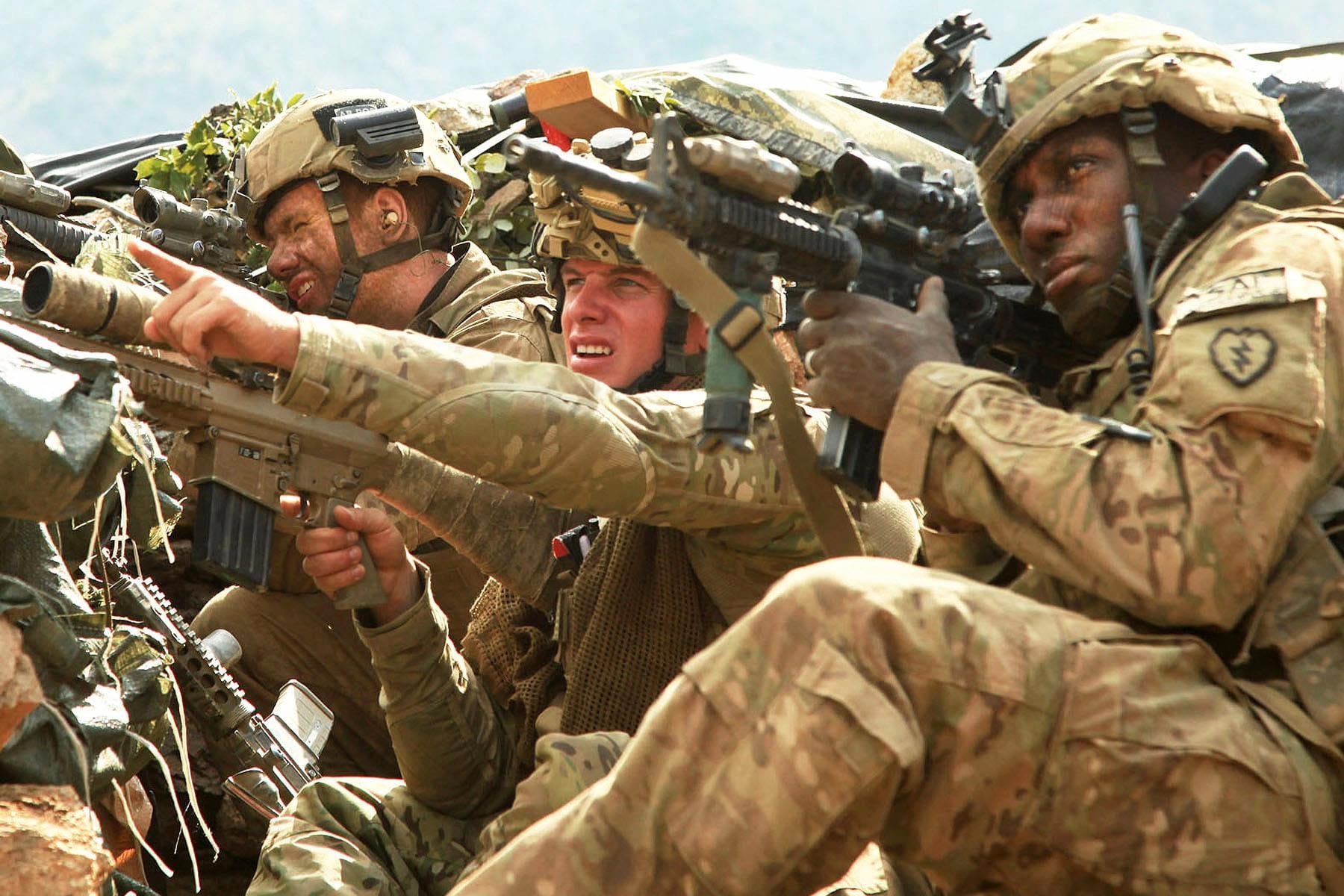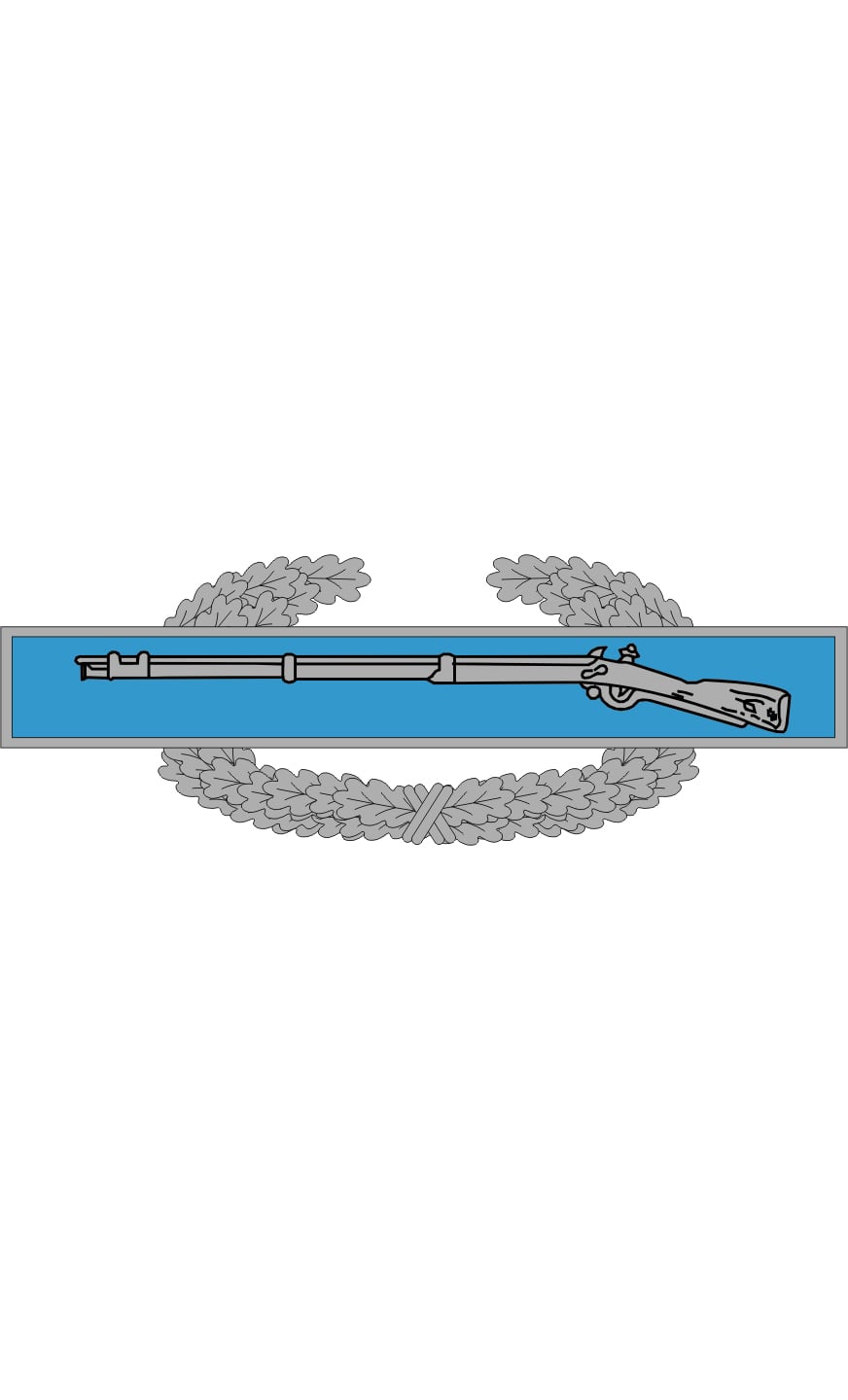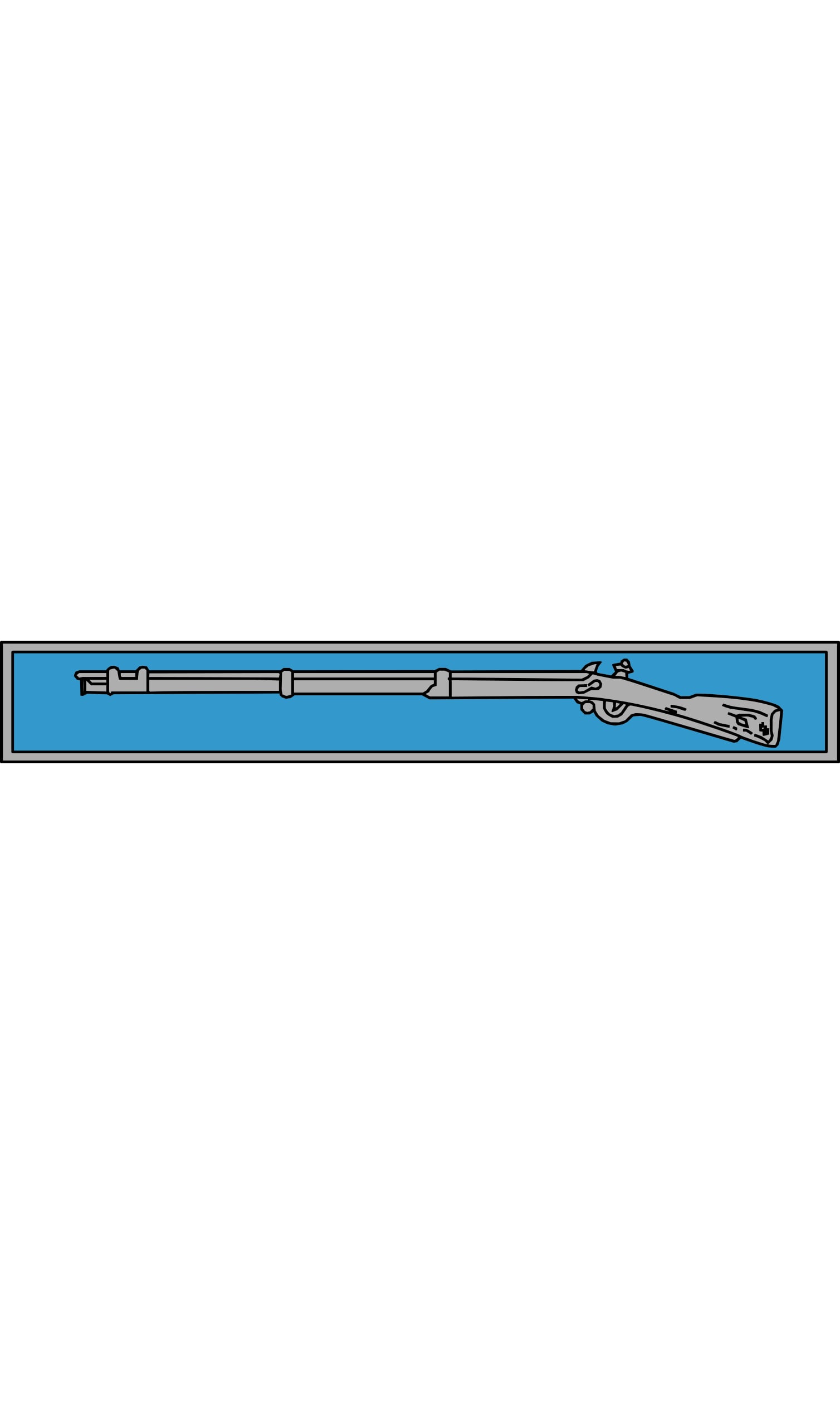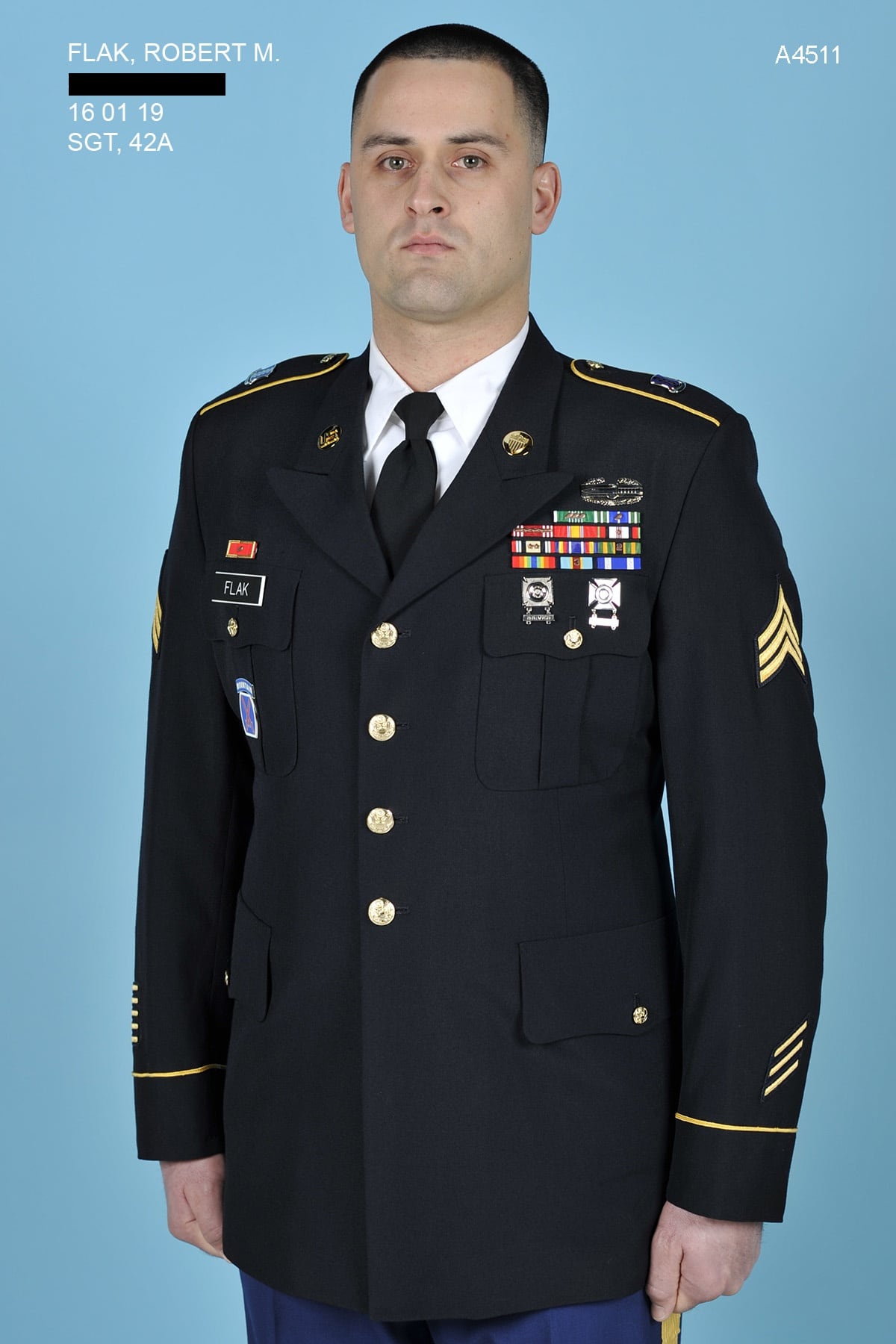If you ask Sgt. Robert Flak, he'll tell you it's not fair that infantrymen who've earned the Combat Infantryman Badge and Expert Infantryman Badge are not allowed to wear both awards at the same time — and he's not even a grunt.
"I was always around the infantry, and I'd hear them talking about how they had to pick between the EIB and the CIB, and … they never get passing recognition from their peers or subordinates or superiors," said Flak, a human resources specialist. "I thought, 'this is not fair,' but they said, 'this is how it is.'"
But Flak feels so strongly about it that he has designed a new badge that would represent both infantry awards, and he's actively spreading the word about the award, talking to anybody who will listen. He's even pitched a written proposal to senior Army leaders, including Sergeant Major of the Army Dan Dailey.
"You go to combat, you survive, you're proven combat effective, then you take the EIB training. Why isn't there a program or a badge or something that provides you that instant dual recognition?" Flak said. "[Infantrymen] deserve it. It's not fair for what they've done and who they are."
Army combat and special skill badges are divided into groups in order of precedence, according to Army Pamphlet 670-1. The Combat Infantryman Badge, which was established during World War II and recognizes infantry and Special Forces soldiers in the ranks of colonel and below who engage in active ground combat, and the Expert Infantryman Badge, which recognizes infantrymen who have demonstrated a mastery of critical tasks and skills, are both in group 1.

A big reenlistment bonus shakeup is adding 35 new jobs but canning bonuses for junior enlisted infantrymen.
Photo Credit: Army
Army regulations allow soldiers to wear "only one combat or special skill badges from either group 1 or group 2" above their ribbons on the dress uniform. This means the CIB and EIB cannot be worn together.
As he's been spreading the word about his idea, Flak thought he would get push back from infantry soldiers — who make up the Army's largest military occupational specialty.
Do you support Sgt. Flak's new badge? Send feedback to Army Times Editor Tony Lombardo.
Email: tlombardo@armytimes.com
There are more than 100,000 infantrymen in all three Army components; about 60,000 are in the active Army.
"But the feedback was so warm, I didn't expect that, since it was coming from a 42A," Flak said.
Flak's idea is to create a new award called the Expert Combat Infantry Badge or the Master Infantry Badge. He's open to other name ideas, but the point is to create an award solely for soldiers who've earned both the CIB and EIB.
He sketched the proposed award during training to become a recruiter this summer.
"I made some really good friends in the infantry MOS, so I started bringing it up and they said it was amazing," Flak said. "That's when I went to my room, I pulled up the CIB and EIB and stared at them for an hour, trying to figure out what to do next."

The Combat Infantryman Badge has been awarded since World War II.
Photo Credit: File
The award he designed is a mix between the two existing badges, with subtle color changes to signify what the new award would represent. The new badge would have a gold infantry musket and wreath instead of the usual silver.
Some people he talked to thought the gold wouldn't work, Flak said, but he countered by saying the Master Recruiter Badge and major rank insignia, among others, are gold.
One thing he didn't touch was the infantry blue on the award.
"That's tradition, and you don't mess with tradition," Flak said.
Staff Sgt. Rusty Hutchison, an infantryman who went to recruiting school with Flak, likes the idea of a badge that represents both awards.
"I thought it was funny when he brought it up because it's a topic I'd heard come up quite a few times with infantrymen," Hutchison said. "A lot of people wish there was a combined badge."

The Expert Infantryman Badge recognizes soldiers who've proven their mastery of critical infantry skills and tasks.
Photo Credit: File
Hutchison, who is leaving 2nd Brigade Combat Team, 82nd Airborne Division, for recruiting duty in Las Vegas, Nevada, has deployed twice to Iraq and has earned the CIB and EIB.
Given the choice of which award to wear, Hutchison said it's a tough decision.
"My EIB signifies I trained hard and I was tested and I proved my skills," he said. "On the other hand, my CIB represent things I did downrange, and it has a relationship to the guys I lost downrange. It's hard for me to pick one of the two to wear. It would be nice to have the option, or in this case one badge to identify both."
Hutchison said he also believes an award like the one Flak is proposing will motivate soldiers to earn their EIB.
"Because of the way the [regulation] was written, you're forced to wear your CIB because it's a higher award," he said. "Soldiers who already have their CIB have lost their motivation in even trying to go out and try and earn their EIB because even if they did earn it, they can't wear it."
If the badge Flak is proposing becomes a reality, "you'll have the few who you know they've been tested at home and tested downrange," Hutchison said. "For an infantryman, I think that would be a great motivator."
Flak said he sometimes is asked why he's working so hard for an award he wouldn't even be able to wear. Flak said this push isn't about him.
"I can sacrifice a little bit of my time to get people the recognition they deserve," he said. "They're the ones keeping me safe at night. They're the ones out there. Why can't they get recognition for something like this?"

Sgt. Robert Flak is proposing a new award that would recognize soldiers who've earned both the Combat Infantryman Badge and Expert Infantryman Badge.
Photo Credit: Courtesy Sgt. Robert Flak
Getting a new award approved by the Army is not easy.
The soldier must submit an award recommendation to his chain of command, said Lt. Col. Janet Herrick, a spokeswoman for Human Resources Command. The submission goes to the Army Chief of Staff via the Awards and Decorations Branch at HRC, and the request "must go through the staffing process to ensure appropriate reviews," Herrick said.
Submissions must include information on training requirements or proficiency levels required for the award; input from the appropriate proponent or Army command; the award approval authority; an outline of basic eligibility requirements; and a description of the proposed badge, according to information from HRC.
"Army leadership has consistently affirmed that although new devices would help promote esprit de corps, it is impractical and cost-prohibitive to recognize each individual duty position, special skill and branch with a special device," according to information from HRC. "The Army has constantly maintained its long-standing restrictive policy to protect the prestige and meaningfulness of existing insignia, badges, ribbons and other devices, to ensure that the recognition provided by existing awards is not duplicated and to preclude uniform clutter."
While the process might be difficult, it is not impossible.
Since January 2011, three badges have been approved by senior Army leaders using this process, Herrick said. They are the Space Badge, Master Recruiter Badge and Army Instructor Badge.
The Army Instructor Badge was the most recent; it was approved by the Army secretary on Dec. 9, 2013. There is currently one badge request working its way through the process, Herrick said. If approved, it would be the Military Horseman Identification Badge.
An award request also can be submitted externally, via a Defense Department initiative or legislation, according to HRC. These requests typically are made by veterans or special interest groups.
Dailey, who was sent a copy of Flak's proposal, has seen the request but feels it's inappropriate to discuss something before it's in the official Army process, according to information from his office.
Flak said he is not deterred.
"I'm S-1, so paperwork is my thing," he said. "If that's what it takes to get thousands and thousands of people recognition, let's go. I'm in this to win this."
Staff Sgt. Christopher Farr was Flak's roommate during recruiting school. Farr, an eight-year infantryman with two combat deployments and the CIB and EIB, was a sounding board for Flak as he designed the new award.
Farr said he likes the idea of a badge that would recognize both awards.
"An EIB means you know your job and you're an expert in your job," said Farr, who is leaving the 101st Airborne Division's 3rd Brigade Combat Team for recruiting duty in Columbia, South Carolina. "The CIB is that you did you job. That's how I explained it to him."
When asked to choose, Farr said he prefers to wear his CIB.
"It's the mark of an infantryman that you have experience in combat," he said. "I personally think that it sets a better standard for lower enlisted, so see somebody they want to follow because he has that experience."
But Farr also credits earning the EIB with giving him an edge for promotion and staying in the Army.
"It helped me excel," he said.
Farr now credits Flak for his dedication to recognizing infantrymen.
"He's a special type of NCO," Farr said. "He doesn't want recognition for anything he does. He just wants to make the Army better."
Michelle Tan is the editor of Army Times and Air Force Times. She has covered the military for Military Times since 2005, and has embedded with U.S. troops in Iraq, Afghanistan, Kuwait, Haiti, Gabon and the Horn of Africa.





